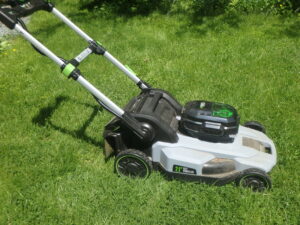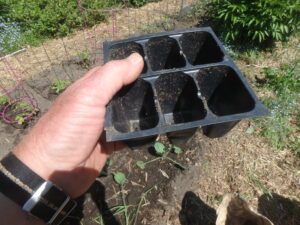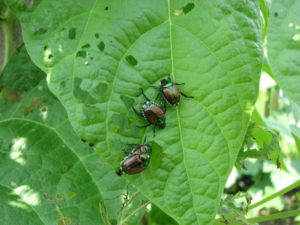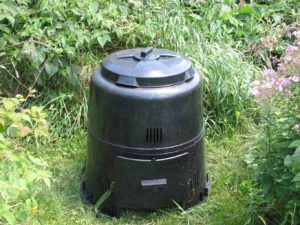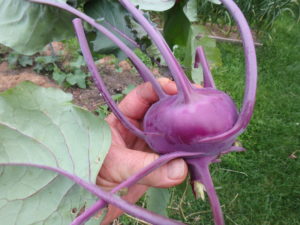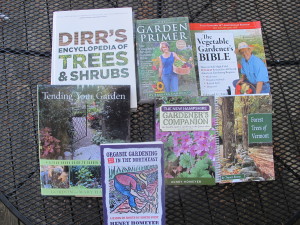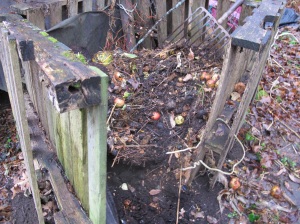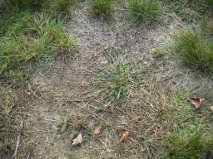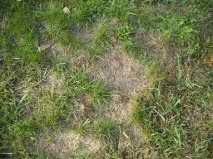Thinking and Being Green in the Garden
First, what should you do with all those black plastic pots that come with the plants? Most recycling facilities do not accept black plastic pots, but some pots are numbered #2 or #5, and can be recycled. A few have no numbers. Plastic pots are made from oil in factories around the world. I imagine that these factories spew and spill a certain amount of chemicals, and create waste and by-products that are bad for the environment.
We recently took a big step forward towards being “Green”. We bought an electric lawn mower. I’ve read that the EPA estimates that using a lawnmower is 11 times more polluting than driving a new car. One hour of mowing, apparently, is equal to driving 93 miles. Of course, these statistics are not perfect, as they do not indicate what kind of mower or car is being compared. Older, bigger mowers are worse.
Lastly, speak up. If your suppliers are trying to reduce use of plastic, or are taking it back to re-use it, tell them that is why you are buying from them. If they’re not? Ask them to! Every voice counts. We gardeners should be on the cutting edge of reducing plastic and chemical use.
7 Resolutions We Can Keep
The holidays have come and gone. Resolutions have been made and broken. Now we New England gardeners are faced with that long, dismal wait before we can start our gardens, and it’s a good time to think about those resolutions we never made: the garden resolutions. If you make – and follow – some of the resolutions below, you’ll not only feel virtuous, you’ll be a better gardener.
Resolution #1. Take the pledge to be an organic gardener. That means using NO CHEMICALS in the garden, no matter how dire the circumstances. Japanese beetles devouring your roses? Get up earlier and handpick them every morning. Weeds in the walkway? No herbicides. Pour boiling water with salt on them, or yank ‘em. Burn them with a blow torch. And forget 10-10-10: no chemical fertilizers, either. There are lots of easy solutions – if you know what to do.
Resolution #2. Read more about organic gardening in this down time before we plant spring seeds. Go to your local library or family-owned bookstore and see what’s available.
Are you a vegetable gardener? Get a copy of Ed Smith’s The Vegetable Gardener’s Bible (Storey Publishing). Ed and his wife, Sylvia live in Vermont and largely live on what they grow. It is well illustrated, and full of fabulous information. They are all, organic, too. This book has stayed in print for 19 years and sold over a million copies.
Another good book to obtain is “Insect, Disease & Weed I.D. Guide” by Cebenko and Martin, Editors (Rodale Press). It came out in 2001, but is still readily available. Organic gardeners have to be a little bit smarter and better educated than chemical gardeners, and this book will not only help you identify pests and diseases, it will offer organic solutions. It’s easy enough to spray a pesticide on a bug, and it will die. But knowing what the bug is, a little about its life cycle, and how to combat it without resorting to chemicals is better.
Resolution #3. Use more compost. Instead of looking for a bagged fertilizer to improve your soil, think long-term. Although bagged organic fertilizers have their place in the scheme of garden things, nothing is better for your soil than compost. Compost is not high in nitrogen, but it introduces beneficial microorganisms to your soil. A teaspoon of compost can contain up to 5 billion bacteria, 20 million filamentous fungi, and a million protozoa. No bagged fertilizer can do that.
Compost also improves the tilth of your soil. Most of us have soil that is either too sandy or too full of
clay. Who do you know that has the “rich, well-drained soil” that every plant book prescribes as the appropriate soil for your favorite plant? We have to make our own soil. We have to nurture it, and improve it until we reach the age of 99, when either it is perfect, or we no longer recognize perfection. Compost helps your soil get there.
Resolution #4. Resolve to mulch more. Mulch will help to smother weeds, add organic matter to the soil as it breaks down, and reduce water loss from evaporation or run-off. Leaves are great anywhere, bark mulch is good in flower beds, and straw, grass clippings and compost are good in the vegetable garden.
Resolution #5. Decide now that you will not let any weeds flower and produce seeds. That means that you have to yank the weed or cut off any seed heads of weeds when you see them – even if you all dressed up and are leaving for the airport. You have to grab the seed heads off that big weed on your way to the car. Stuff it in your pocket, or put it in the trash. But don’t let the weeds spread their seeds.
Resolution #6. Experiment. Every year plant something new, whether a new flavor of tomato or type of zinnia. Try veggies you’ve never grown, and learn to love eating them. Kohlrabi and rutabagas are actually delicious. Try a new type of watering device, or get a new weeding tool (such as the CobraHead, my favorite). Plant a new species of tree, one that flowers.
Resolution #7. And last but not least, resolve to keep gardening fun. Don’t bite off more than you can take care of. Try not to get discouraged if beetles eat your lilies or the phlox gets moldy. Gardening is supposed to be fun – that’s why so many of us do it. Accept that organic gardeners suffer some losses and that no gardener can have success with everything. In the meantime, enjoy the winter, and learn more about organic gardening now – so you’ll be ready come spring.
Henry lives and gardens in Cornish Flat, NH. E-mail him at henry.homeyer@comcast.net.
Holiday Gifts for the Gardener
It’s that time of year again. Time to think about buying gifts for our loved ones. For gardeners there are so many things, selecting something is easy – from under $10 to over $500. Let me play Santa, offering you ideas to choose from – or things to avoid.
Let’s start with the no-no’s: Unless your sweetie has asked for more houseplants, don’t buy houseplants. The only exception to that might be an orchid in bloom – if she can consider it like cut flowers and jettison it after it finishes blooming. But in general, houseplants are work, and require space on a windowsill. Likewise avoid buying a do-it-yourself beehive kit or an earthworm farm for digesting the leftover lettuce that would otherwise go in the compost.
On the other hand, a truckload of good compost would be welcomed by almost any gardener. Just don’t have Santa deliver it on the driveway. Santa has to deliver to the garden, or near the garden. Composted barn scrapings are sold by most dairy farmers and garden centers, and by some lawn maintenance companies. Ask for “hot composted manure” or aged barn scrapings. The hot composted stuff should not have any viable weed seeds.
Garden gloves are good gifts. These range in price from $6.95 to $24.95. Now days you can even get them in pink. Me? I like the stretchy gloves impregnated with latex on the palms, but not on the backs, so hands can breathe.
Last summer I got a set of deer-repelling blinking lights. Quite innovative. They are solar powered, and emit a red LED light all night that scares deer or other pests. It is called Nite-Guard Solar (www.niteguard.com). You need at least 4 of these devices, so that one is facing each direction around the garden at eye-height of the deer or raccoon. In my limited use, they seem to be a big help. Of course, with heavy deer pressure, only an 8-foot fence is 100% effective.
Speaking of deer, another problem they present is Lyme disease, carried by ticks that deer and mice carry. There is a gaiter available that is impregnated with permethrin. These gaiters wrap around your pants to prevent ticks from getting to you – and to kill them if they try to attach to your pant legs. If you have a lots of ticks, these may be a great help. Available on line at www.Lymeez.com. This is a new version of one that I tried earlier, and the manufacturer assures me it will be ready for shipment by December 19.
I’m not, in general, a big fan of rototillers, but was given a little one to try out last spring. It’s called the Mantis tiller (www.mantis.com). It only weighs 24 pounds and digs down to a maximum of 10 inches. I used it for working compost into the top 6 inches of my vegetable garden and found that it did a good job. It starts easily and runs well.
My basic complaint with large tillers is that they can go down 18 inches or so, moving microorganisms from one soil depth to another. This little guy is less likely to do that. Big ones can also damage soil structure, particularly if wet.
This summer I got a sauerkraut crock from Gardeners Supply (www.gardeners.com) and like it a lot. Mine has a 1.3 gallon capacity, and comes with a kit that includes weights to keep the kraut submerged. It has a water-sealed air lock for the cover which allows the gases to be vented, but no extraneous air-borne yeasts or bacteria to enter it.
Every year I mention my favorite weeding tool, the Cobrahead Weeder (www.cobrahead.com). It is available everywhere now because it really works: like a single steel finger it can tease out long grass roots, prepare a place for a tomato seedling, or get under a big weed, allowing you to pull from above and below. If your Sweetie doesn’t have one, get one, and she’ll love you even more!
Books are always good gifts. I recently got a copy of a nice book by Vermont garden designer and author Gordon Hayward and his wife Mary called Tending Your Garden: A Year-Round Guide to Garden Maintenance. Hayward is a hands-on guy who knows a lot, and the book if full of lovely photos and sensible ideas. I also love his book, Stone in the Garden. In fact, I like all his books!
Forest Trees of Vermont by Trevor Evans is one of the nicest guides to trees I have seen. Great photos, easy-to use, it even comes with a little ruler for measuring leaves! Applicable anywhere in the Northeast. Available from Forestry Press, www.ForestryPress.com.
In general, if you like an author, any book by the same author will be good. Thus you could look for books by Michael Dirr (trees, shrubs), Barbara Damroch (general gardening), Ed Smith (vegetables) or Sydney Eddison (flowers and design). And I would be remiss if I didn’t mention my own books – they cover just about everything, but with an organic bias. My New Hampshire Gardener’s Companion is just out in an updated second edition and is relevant anywhere in New England.
Lastly, if you really don’t know what to get or are too busy to find something good, get a gift certificate to a local, family-owned garden center and let your loved pick a gift. Every serious gardener lusts after new perennials and shrubs, so why not facilitate the process with a gift certificate? And the garden centers would be happy for your business at this, a slow time of year.
Henry’s website is www.Gardening-Guy.com. Send questions to him at henry.homeyer@comcast.net.
Leaves and Compost and Mulch, Oh My!
Even if you raked your leaves in October, you probably have some more to clean up now. I do. Of course I was off gallivanting for much of October and hadn’t done any raking until recently. Still, trees like oaks and apples are still dropping leaves.
When I was a boy in Connecticut, my gardening Grampy would take the train or a bus from Spencer, Massachusetts each fall to visit us. In addition to getting some homemade apple pie and seeing his grandchildren, he came to help us rake the leaves. We lived in the country with close to an acre of lawn, I’d estimate, surrounded by a mixed hardwood forest. A lot of leaves fell –or blew- onto that lawn.
If you are of a certain age, you remember that back in the 1950’s there were no blue plastic tarps. We only had a wheelbarrow – one we called “the leaf cart” – to carry off many bushels of leaves. But Grampy was a tailor by trade, and made something to spread out on the lawn. He sewed together old sheets or bedspreads to make a large square of cloth, and brought it with him when he came each year. We raked the leaves onto that and when it was full, he drew the 4 corners together. Then, like Santa about to go down a chimney, he loaded it onto his back and carried it away.
Those leaves slowly broke down and made some of the most delicious compost you could ever imagine. Dark in color, it was loved by earthworms and was a great addition to our vegetable garden, flower pots and flower beds a few years after the leaves were collected.
It makes sense that leaves would make great compost. Trees mine the soil, bringing up minerals that end up in leaves. And, by the miracle of photosynthesis, trees make sugars and carbohydrates that build plant bodies. Re-using these elements is the original recycling. Trees have been dropping leaves and letting the bacteria, fungi and fauna of the forest break them down and re-use the elements for ages. Collecting them for use in our gardens is our way of capitalizing on a natural process.
Long ago I visited garden writer Sydney Eddison in her Connecticut garden. It was towards the end of a prolonged summer drought, one so bad that mature oaks were dying. There was a watering ban, but her flower gardens were thriving and, when I felt the soil, it was lightly damp. I asked her how she did it.
It was simple, she said. For 30 years her husband, Martin, had collected leaves each fall, running them over with a lawnmower and bagging them. He saved them in the barn, and in the spring Sydney spread out the chopped leaves and lawn grass around her perennials after they appeared. This mulch kept down weeds, attracted earthworms and enriched the soil. And it held moisture.
I use my leaves in the garden, too, though I do not bother bagging them. Most I spread over my mounded, raised vegetable beds after they have been weeded and re-shaped in the fall. They keep weeds from getting an early start, and keep out weed seeds that are blowing in the wind. Because they have been chopped, they don’t blow around much, and certainly not after a rain.
My neighbors, Susan and Joel Kinne, collect their leaves and put them in a bin they made with steel fence posts and wire mesh. It is about 4 feet on a side, and 4 feet high. I’ve seen the compost they have harvested from their bin, and it is gorgeous. Any self-respecting plant would love some in its soil. According to Joel, it takes between 2 and 3 years to go from leaf to compost, and they never bother turning the pile or doing anything else for the leaves.
I take my food scraps and the leaves and stems of kale, carrots and other veggies and toss it in a bin I made from old wood pallets. I have to admit I rarely bother to collect the compost – it is more a way of keeping vegetable matter out of the waste stream than making compost. But recently I took off one side of the bin and dug out some of the material from deep under this years’ additions.
I was amazed at the number of earthworms in the top layers – this year’s waste. There hundreds, perhaps thousands. Wriggling and squirming, small ones, medium sized ones. That’s good. They eat the food and their waste, called castings, is high in nitrogen and other minerals necessary for plant growth. More importantly, they are good sources of materials that create good tilth and texture in soil.
Deep down I harvested a bucket of black compost. It was fluffy, despite being pressed down by many pounds of matter above it. I could see bits of eggshell, but everything had been processed. I’ll mix it 50-50 with potting soil and use it to replant houseplants, giving them a fresh infusion of nutrients.
When I was a kid we jumped in the piles of leaves Grampy collected, but I think now, as a (considerably) heavier person, doing so might lead to broken bones. Still, I treasure those memories … and my leaf compost.
Henry is a UNH Lifetime Master Gardener the author of 4 gardening books. His website is www.Gardening-guy.com.




